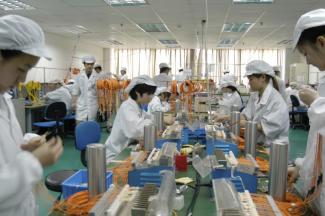Relevant reading
Debate on industrial policy
 Pape/Lineair
Pape/Lineair
In 1993, the World Bank’s East Asian Miracle Report staked out a clear position: it attributed East Asian success first and foremost to macroeconomic stability and healthy fundamental data. In other words, sound macroeconomic management, free trade and investments in infrastructure and education were believed to be at the root of healthy development. The report acknowledged that many of the countries considered had relied on targeted government action in terms of agricultural policies, aid for exports, subsidised credit and deliberate reallocation of resources. Nonetheless, the authors stated that such government action had not been the main driver of success.
Alice Amsden (1994) and many other analysts strongly criticised the report’s conclusions and recommendations. Amsden objected in particular to the World Bank’s claim to neatly distinguish fundamental factors from interventionist policies. She felt it would make more sense to find out how to build the kind of strong institutions that had led to convincing results because they were able to implement industrial policies in East Asia.
The topic was then dropped. It seemed as if the World Bank’s point of view had prevailed. Experts only took the issue up again in the early 2000s. In a book he co-edited (Arbache et al., 2008), John Page, one of the authors of the East Asian Miracle Report, showed that the industrial sectors of many African countries had begun to shrink after a brief period of growth that had been driven by government investments and import substitution. Page’s data indicated that the share of manufacturing industries in most African countries’ GDP was smaller in 2000 than it had been in 1985. This development contrasted with trends in most Asian and Latin American countries.
Dani Rodrik (2014) argues along similar lines. He laments the slow progress of industrialisation in Africa, showing that, even at comparable income levels, the share of manufacturing in employment as well as GDP was much larger in East and Southeast Asian countries. Rodrik sketches a typology of growth in order to predict its pace. He notes that, even though “fundamentals” have been good in much of Africa, industrialisation remains weak. Accordingly, he forecasts slow economic growth for the continent in the future.
Rodrik discusses four policy options: (i) development and promotion of the manufacturing industries, (ii) agribusiness, (iii) specialisation in the services sector and (iv) commodities-based growth. Rodrik assesses these options with a particular focus on the scope for job creation. From this perspective, he argues that option (i) is the most promising. A the same time he argues that shifts in global demand will make it harder for Africa to find suitable export niches than it was for other regions in the past.
Margaret McMillan sees Africa’s development much more optimistically (McMillan and Harttgen, 2014). She points out that the number of micro and small enterprises has risen fast and that they have absorbed many workers from agriculture. Despite their small size, these companies have higher productivity levels than farms. McMillan reads this as a sign of considerable progress towards industrialisation, though it differs from the kind seen so far in East and Southeast Asia.
A collection of essays edited by Adam Szirmai, Wim Naudé and Ludovico Alcorta (2013) provides an excellent overview of the possible pathways for industrial policy. It draws on experiences gathered in East Asia, China, Indonesia, Latin America and Africa. In general, the contributors appreciate that industrial policy is useful, but they offer very differentiated perspectives. In a chapter on Africa that echoes his argument in the East Asian Miracle Report, John Page calls for measures to improve the business climate, investments in infrastructure and human capital as well as more regional integration. In the same volume, Tilman Altenburg points out that industrial policy is unlikely to deliver results in countries where politics and the economy are still primarily directed and controlled by (corrupt) elites.
The book contains three chapters that consider industrial policy in the context of climate change and sustainability. They are very much worth reading and focus on challenges of international coordination, informal recycling and measures to promote low-carbon industrial growth. Industrial policy is seen as a tool that can contribute to international climate goals. If it reduces the relevance of land-hungry agriculture, for instance, it helps to stem deforestation.
Mario Cimoli, Giovanni Dosi and Joseph E. Stiglitz (2009) published an earlier, interesting book on these matters. They consider industrial policy an important instrument to promote economic development. However, they used a very broad definition of the term, which encompasses policies concerning trade, research, technology and foreign direct investments.
Within the World Bank, a clear case has yet to be made in favour of industrial policy. But the instrument is once again considered to be worthy of debate. A wide range of opinions is found, from complete rejection to enthusiastic support.
A prominent proponent of industrial policy is Justin Yifu Lin (2012), who was the chief economist and senior vice president of the World Bank from 2008 to 2012. In his book, Lin recommends that emerging economies focus on their comparative advantages. In choosing production technologies and products, industrial policy should look for guidance to how an advanced economy which started from similar initial conditions developed. The economy picked as model should not only be operating at the international technological frontier, but contributing to pushing it further outward. By following a successful example, developing countries should be able to grow much faster than the more advanced economies.
According to Lin, the continuous upgrading of industrial structures and the improvement of infrastructure require coordinated investment and the compensation of externalities. But he argues that the state must assume an active role as private companies cannot do these things on their own. The book is clearly a reflection of Lin’s own experiences in China. Accordingly, he pays almost no attention at all to the problem of weak institutions.
According to Shanta Devarajan (2012), however, this is the crucial problem. Devarajan is the World Bank’s chief economist for the Middle East / North Africa region and argues that poor governance is at the root of market failures. So the best way to promote structural change is not industrial policy, but stemming government shortcomings. In sum, it is not surprising that Lin’s approach is not supported by consensus within the World Bank. There is one likely exception: agreement seems to be widespread concerning Africa’s need for substantial public investments in infrastructure.
Michael Grimm is a professor of development economics at the University of Passau.
michael.grimm@uni-passau.de
References:
Amsden, A. A., 1994: Why isn’t the whole world experimenting with the East Asian model to develop? In: World Development, Vol. 22: 627–633.
http://sites.utexas.edu/chinaecon/files/2015/06/Amsdem_Response-to-East-Asian-Miracle.pdf
Arbache, J. S., Go, D. S. and Page, J., 2008: Africa at a turning point? Growth, aid, and external shocks. Washington: World Bank.
http://documents.worldbank.org/curated/en/2008/01/9484180/africa-turning-point-growth-aid-external-shocks
Cimoli, M., Dosi, G., and Stiglitz, J. E. (eds.), 2009: Industrial policy and development. The political economy of capabilities accumulation. Oxford: University Press.
Devarajan, S., 2012: In defense of industrial policy.
http://blogs.worldbank.org//africacan/in-defense-of-industrial-policy
Lin, J. L., 2012: The new structural economics. A framework for rethinking development and policy. Washington: World Bank.
https://openknowledge.worldbank.org/bitstream/handle/10986/2232/663930PUB0EPI00nomics09780821389553.pdf?sequence=1
McMillan, M., and Harttgen, K., 2014: What is driving the ‘African growth miracle’? Tunis: African Development Bank.
http://www.afdb.org/fileadmin/uploads/afdb/Documents/Publications/Working_Paper_-_209_-_What_is_driving_the_African_Growth_Miracle.pdf
Rodrik, D., 2014: An African growth miracle? Princeton: Institute for Advanced Study.
https://www.sss.ias.edu/files/pdfs/Rodrik/Research/An_African_growth_miracle.pdf
Szirmai, A., Naudé, W., and Alcorta,. L. (eds.), 2013: Pathways to industrialization in the twenty-first century. New challenges and emerging paradigms. Oxford: University Press.
World Bank, 1993: The East Asian Miracle: economic growth and public policy. Washington.
http://documents.worldbank.org/curated/en/1993/09/698870/east-asian-miracle-economic-growth-public-policy-vol-1-2-main-report


